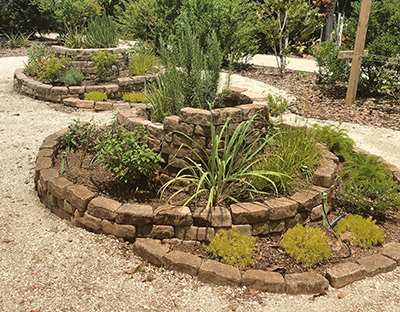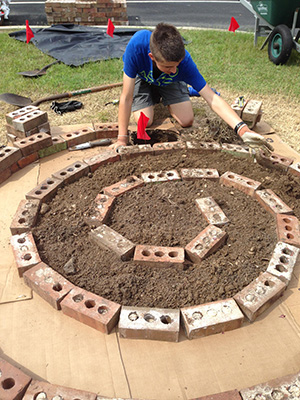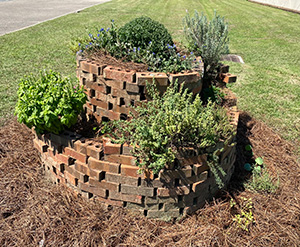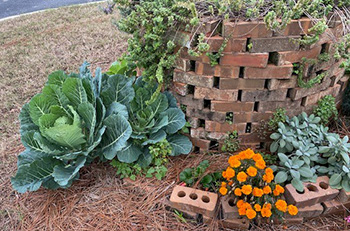Spiral Herb Garden Tutorial

Photo courtesy of Jamie Daugherty, UF/IFAS Extension
Looking to "spice up" your herb garden? An easy way to add interest is by building an herb spiral. Not only are the spirals attractive to look at, but they have the added benefit of creating various microclimates within the spiral. Different parts of the spiral will have varying moisture and light conditions, which means you can plant your herbs where they will thrive.
Step 1: Gather Materials
First you'll need to decide which material to use for the spiral. Master Gardener Volunteers with UF/IFAS Extension Bay County used brick for theirs, which is an easy pick for stability. Wood, stone, and pavers are alternative options. This is an excellent opportunity to repurpose materials you or your neighbors have already, so look around before purchasing new bricks, pavers, etc.

Master Gardener Volunteer laying out a spiral garden. Photo courtesy of Julie McConnell, UF/IFAS Extension
Materials
- Spiral materials (such as bricks, stone, pavers, or wood)
- Cardboard
- Weed barrier
- Bagged topsoil
- Mulch
Step 2: Choose a Location
The ideal place for your herb spiral is level ground that receives plenty of sunlight. A level location will make building the spiral easier, and full sun is important because by design, the spiral will be providing shade to the plants that need it.
Step 3: Lay Down the Base
Begin by spreading out your weed barrier. This will help prevent weeds from joining the herbs in your spiral. Then lay your cardboard down on top of it. The cardboard serves as an additional layer of protection that will break down over time and feed the soil.
Step 4: Build the Spiral
Now is the fun part: building your spiral! There are no set rules for the height or width of the spiral, but the typical width is six feet. The size may also depend on how much material you have, especially if you are using repurposed materials.
You can start by drawing your spiral on the cardboard, and then laying the first layer of material on top. After making any needed adjustments, continue stacking until the spiral is the desired height. Make the spiral tallest in the middle, and progressively shorter towards the outer edge. As you are building the walls higher, add your bagged soil to support the walls and provide a bed for your herbs.
Step 5: Add Your Herbs

Photo courtesy of Julie McConnell, UF/IFAS Extension
Which herbs you choose to plant will depend on the time of year and personal preference. Keep in mind the size and spread of fully grown herbs when determining their placement. For example, lemongrass and rosemary are not suitable for the top row because they will grow quite tall and overwhelm the spiral.
Make sure to place your chosen herbs where they are most likely to thrive. Each side of the spiral will experience different light intensities depending on whether it is facing north, east, west, or south. Plants on the north and south sides of the spiral should be happier in partial shade, and those on the east and west sides should want full sun. In addition, water will travel from the top of the spiral down to the bottom after irrigation. To account for this, you should plant water-loving plants towards the bottom and plant more drought-tolerant herbs at the top.

Collards and marigolds have been planted at the base of this spiral garden. Photo courtesy of Julie McConnell, UF/IFAS Extension
Some herbs that tend to do well in the spiral are basil, parsley, thyme, oregano, lavender, and sage. You can also make the spiral more interesting by planting seasonal flowers and vegetables alongside the herbs.
After planting, top your soil with a mulch of your choice, such as pine straw. You can also surround the spiral with mulch to give it a finished look and prevent weeds. Drip irrigation can be installed at this point, if desired.
Also on Gardening Solutions
Thanks to Extension Faculty Julie McConnell with UF/IFAS Bay County Extension for providing her expertise on building herb spirals.

